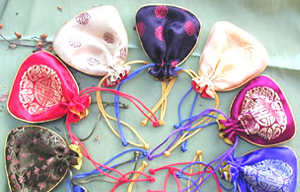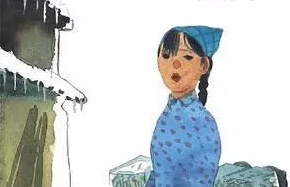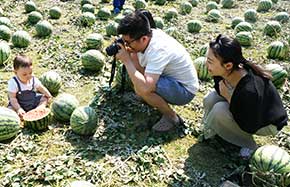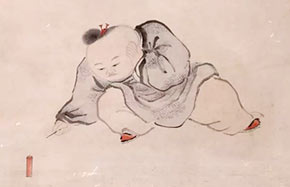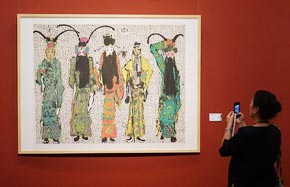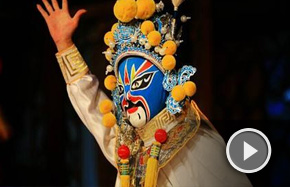Paintings about the Dragon Boat Festival
 |
|
A long-scroll painting of the Painting of Nine Songs, held in the Jilin Museum in China, painted by Zhang Wo, the Yuan Dynasty |
A long-scroll painting of the Painting of Nine Songs, which was created based on Nine Songs written by Qu Yuan, is held in the Jilin Museum in China. It was painted by Zhang Wo, a painter from the Yuan Dynasty (1271-1368). The fist painting of the scroll is a figure of Qu Yuan, while the remaining 10 paintings are 10 immortals. On the 6-meter scroll, the painter depicted 11 scenes. On the painting, Qu Yuan is standing there, wearing a bag-sleeve long gown. He looks gaunt and haggard. Although he is deeply worried, he still possesses civility.
The painting is the earliest image of Qu Yuan among existing ancient paintings of China. The painter adopted an outline drawing to depict Qu Yuan in his imagination. Depicting images with lines only is an artistic form and a painting branch peculiar to Chinese paintings. It is interesting that it counters western sketches which show images with surfaces. They complement each other. The painting of Zhang Wo is said to be the best masterpiece among outline drawing classics which were handed down from ancient times. The lines are mellow and full with agility. It is said to have achieved the highest state of outline drawing.
The Painting of Nine Songs has combined three kinds of art – poetry, calligraphy and painting. Each painting is provided with a poem in seal character, whose content comes from Nine Songs, which was adapted from folk ritual songs from Chu State by Qu Yuan. There are 11 cantos in total, including God of Xiang, Madame Xiang, The Chinese Apollo, River God, Goddess in the Mountain and Sacrifice Soul. Contents of National Martyr and Sacrifice Soul are mainly about condolence and glorification of officers and soldiers who died in battle for Chu State. Other cantos mainly focus on sentimental attachment between gods to express the deep yearnings and the sentimentality caused by the wreck of hopes. In fact, Nine Songs was sung in sacrificial activities, sacrificing nine gods or martyrs in Chu State. Qu Yuan put it in order and made it a great literary work. Images in the piece are vivid so the painter can easily express them. Of course, there are great difficulties in expressing them. How does one interpret words into images?
According to historical data in the history of China, Li Gonglin, a painter from the Song Dynasty (960-1279), was the first one to create painters with the theme of Nine Songs. However, his works were not handed down.
Zhao Mengfu from the Yuan Dynasty, Chen Hongshou of the Qing Dynasty (1644-1911) and Xu Bangda, a modern painter, have also created Painting of Nine Songs. Most of these paintings also adopted outline drawing.
It was more than 1,500 years after the death of Qu Yuan when Zhang Wo painted Painting of Nine Songs, from which we can see that the Chinese have a long history of commemoration for Qu Yuan. The reason people commemorate Qu Yuan is his patriotism, faithfulness and talents – all things that fall in line with the standard of a perfect personality in the opinions of Chinese. Therefore, Qu Yuan was a historical figure to be commemorated by all dynasties.
|
|
|




